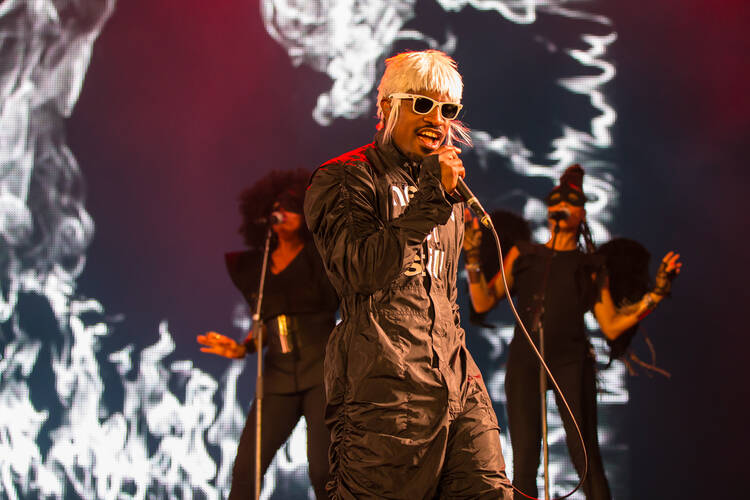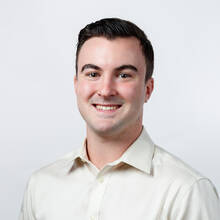I am often faced with a conundrum as a regular concert-goer: Do I record a favorite song during the concert as the artist is performing and have the luxury of rewatching the experience as often as I like later, or do I keep my phone in my pocket in order to be truly present in the moment instead?
On Jan. 31 at the Blue Note jazz club in New York City, hip-hop legend turned jazz flutist André 3000 didn’t give the audience a choice. As guests entered the Blue Note, they were required to place their phones in a small mesh bag to be returned to them after the show.
It was likely to limit the possible disturbances that phones can create—it appears André 3000’s team is making a film for his “New Blue Sun” tour—but perhaps André requested no phones in response to his ideas on fame.
“Being famous really sucks, man,” André said in a recent interview. “It’s so inhuman. It’s unnatural to have that much admiration because it changes the way you think and move.”
André’s thoughts on fame are certainly understandable, as the nine-time Grammy-winning artist has been placed in the pantheon of hip-hop legends like Jay-Z or Nas. Outkast’s magnum opus, “Speakerboxx/The Love Below,” recently became the best-selling hip-hop album of all time.
Rather than having phones shoved in his face, it seems that André wanted the focus of the night to be on the music.
My dad has been my concert partner for as long as I can remember. He took me to my first-ever concert, the rock band blink-182 with My Chemical Romance as the opening act, as a young pop-punk fanatic in the fifth grade. He showed me the joy of exploring new genres as my musical palate expanded and I developed a love of jazz music.
My dad and I were there for saxophone virtuoso Kamasi Washington’s first New York City set in August of 2015, which also happened to be at the Blue Note. By chance, we bumped into Kamasi upstairs after the show and had the opportunity to chat with him and snap a picture. The Blue Note has been and continues to be a venue that provides fond memories for the two of us.
But to this fan who loves both his discography with OutKast and his jazz music, André did not need to apologize; his set was nothing short of spectacular.
After I caught up with my dad before the show, it was time for André and his supporting band—composed of the percussionist Carlos Niño, the pianist Surya Botofasina (who was a member of Alice Coltrane’s spiritual ashram), the drummer Deantoni Parks and the guitarist Nate Mercereau (whom André called the “Jesus of the group” at some point in the performance)—to take the stage.
The decorum of jazz shows can often produce the feeling that one is watching theater more than a concert, with some newer fans of jazz not always able to identify when in a performance it is appropriate to applaud. But André immediately wanted to relieve the Blue Note crowd of any inhibitions in reacting to the music. “Make noise if you wanna make noise, be quiet if you wanna be quiet, and cry if you wanna cry,” André told the crowd before the band began playing.
André’s authentic, eccentric self is present in the tracklist and length of songs on “New Blue Sun.” You’d be hard-pressed to find an artist making 12-minute-long songs with titles like “I Swear, I Really Wanted to Make a ‘Rap’ Album but This Is Literally the Way the Wind Blew Me This Time” (which appeared on the Billboard Hot 100), but André is among a small number of artists that can thread the needle between commercial success and artistic boundary-pushing.
André’s (perhaps cheeky) apologetic attitude for possibly leaving fans of his illustrious hip-hop career hanging by pursuing the flute must have still been in the front of his mind at the Blue Note, as he yet again told fans that he was sorry for not making another rap album.
But to this fan who loves both his discography with OutKast and his jazz music, André did not need to apologize; his set was nothing short of spectacular.
Before diving into his set, André reminded the crowd that the music we were about to hear would never be replicated. While he may have been pulling from compositions off of “New Blue Sun,” André and his band wanted to make sure the crowds were hearing new iterations and improvisations of the music each night.
While I have heard other jazz flutists like Shabaka Hutchings perform live in venues such as Le Poisson Rouge, the intimate atmosphere the Blue Note provided was unmatched. The warm blue hue of the stage lights shone down on the band while André and Co. took the crowd time-traveling with their performance. Some sections of his performance sounded like an ancient Chinese composition, while other points of the set sounded like I was about to be whisked away on an alien spaceship.
André noted the fact that “every culture has flutes,” and his commitment to exploring wind instruments from all over the world was evident when he set aside his flute and picked up a modified bagpipe that he claimed was purchased right around the corner from the Blue Note a few hours before the show.
While playing yet another psychedelic cut from “New Blue Sun,” “That Night in Hawaii When I Turned Into a Panther and Started Making These Low Register Purring Tones That I Couldn’t Control…,” André chose to divulge stories from his childhood rather than his ayahuasca-soaked adventure to which the song refers.
He recalled imagining acting like a panther when he was a kid, shape-shifting between being human and animal. He then told the crowd about lying as a child about being from New York City, when in fact he would often move from city to city. “I just told ‘em I was from somewhere in the 100’s with a New York accent and they bought it,” he told the crowd. This vivid childhood imagination must have been on André’s mind throughout the show, as he went on to explain how he believes being an only child often forced him to use his imagination for company and comfort.
“There was certainly a spiritual dimension to what was happening, and there was a certain kind of reverence.”
Not having my phone to record challenged my capacity to access my memories of the show: That seems appropriate. When a shooting star passes, you don’t have time to capture a photo of it on your phone. And that’s what André’s set was: a meteor passing through Washington Square, never to be seen or heard again.
My seat happened to be directly next to the stairs where André and his band walked off stage. We made eye contact, and without thinking I stuck out my hand and thanked André for such an amazing set. He thanked me back and went on his way. My dad and I couldn’t get over it; it was almost like I was back at the Blue Note as a 14-year-old meeting Kamasi Washington.
“New Blue Sun” is a spiritual jazz masterpiece rooted in the restless artistic spirit of an artist with once-in-a-generation talent. “I think these are kind of ‘earth suits,’ André told Stephen Colbert about human bodies when asked about the afterlife. “I think that energy goes into something else or to another thing that we can’t even imagine. The energy transfers.”
After his performance at The Blue Note, André and the band ventured into Brooklyn to St. Ann & the Holy Trinity Church for his next couple of sets, a testament to his interest in exploring the intersection between spirituality and jazz.
The Rev. John E. Denaro, the rector of the parish, spoke with America about his decision to open the space in the historic Episcopal church to André and the long history of the church as a performance space.
That’s what André’s set was: a meteor passing through Washington Square, never to be seen or heard again.
Some previous artists to perform at St. Ann’s, which Father Denaro said had “good karma for performers,” include David Byrne of Talking Heads fame, Marianne Faithful and perhaps most famously, Jeff Buckley, who performed at the church as part of a tribute to his father.
The parish “has made it intentionally part of [their] mission” to ensure that St. Ann’s isn’t “disconnected from the world outside,” said Father Denaro. “A lot of churches have closed; they've been turned into condos or they've been turned into event halls or venues. And I don't want that.”
He viewed André’s performance at St. Ann’s as “a heartening thing” that was “packed to the gills,” with a wide amount of variety in the gender, age and race of the concertgoers.
Father Denaro thinks it is apt to refer to André’s New Blue Sun Tour as spiritually informed.
“The story of the Transfiguration is about all the disciples Jesus takes with him, who were just completely dumbstruck and flummoxed,” he said. “It's that sort of otherworldly experience; maybe it’s similar to the experience people are having at a concert like this. There was certainly a spiritual dimension to what was happening, and there was a certain kind of reverence.”
With his new performances, André is giving the opportunity to pray back to his audience, guiding them on a reflective prayer led by a flute; joining a long lineage of other jazz artists with music rooted in spirituality in the process.








